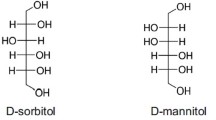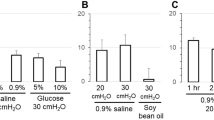Summary
Using the modified Sperber technique in the hen the relationship between renal tubular secretion and urinary excretion of electrolytes of three alkaline diuretics was studied. The true tubular excetion fraction (TTEF) averaged 0.39, 0.60 and 0.01, respectively for amiloride, tizolemide and MK-447. Thus, there was extensive active tubular secretion of amiloride and especially of tizolemide, while a tubular secretion of MK-447 could not be established. The TTEF values of amiloride and tizolemide were significantly reduced by coadministration of mepiperphenidol (Darstine), an inhibitor of organic cation transport while these values were unaffected by the organic anion transport inhibitor novobiocin. Thus, amiloride and tizolemide are transferred from peritubular blood to the urine by an organic cation transport system, thereby significantly increasing the intraluminal concentration of the respective diuretic. This contributed significantly to the urinary electrolyte effects of each drug (in the case of amiloride a natriuretic and potassium-sparing effect and for tizolemide mainly a saluretic effect) since these effects were elcited predominantly on the ipsilateral side after renal portal infusion of the diuretic on one side and coinfusion of Darstine significantly reduced these excess excretions. Assuming a distal site of action, it seems therefore that a significant part of the renal electrolyte effects of amiloride (tizolemide) are coupled to its active tubular secretion and evoked from the luminal (urine) side of the avian nephron. In further support of a direct action of these diuretics on tubular cells, the renal clearances of 51-Cr-EDTA and 125-I-Na-o-iodohippurate were symmetrical during unilaterallity in electrolyte excretions. There was a small but significant ipsilateral excess saluresis after portal infusion of MK-447 that was not reduced by Darstine. This might be related to the higher concentrations of MK-447 in peritubular blood on the side of the infusion. It is suggested that MK-447 reaches its site(s) of action primarely by passive diffussion from the peritubular side of the nephron.
Similar content being viewed by others
References
Baer JE, Jones CB, Spitzer SA, Russo HF (1967) The potassium-sparing and naturetic activity of N-amido-3,5-diamino-6-chloropyrazinecarboxamide hydrochloride dihydrate (amiloride hydrochloride). J Pharmacol Exp Ther 157:472–485
Barratt LJ (1976) The effect of amiloride on the transepithelial potential difference in the distal tubule of the rat kidney. Pflügers Arch 361:251–254
Beyer KH, Tillson EK, Russo HF, Paulson SF (1953) Physiological economy of Darstine, 5-methyl-4-phenyl-1-(1-piperidyl)-3-hexanol methobromide, a visceral anticholinergic agent. Am J Physiol 175:39–44
Bryant IM, Yu TF, Berger L, Schwartz N, Torosdag S, Fletcher L, Jr, Fertig H, Schwartz MS, Quan RB (1962) Hyperuricemia induced by the administration of chlorthalidone and other sulphonamide diuretics. Am J Med 33:408–420
Carrasquer G, Fravert DG, Olsson AK (1974) Effect of intraluminal amiloride on Na transport in the rat proximal tubule (38130). Proc Soc Exp Biol Med 196:478–480
Chonko AM, Grantham JJ (1976) The use of the isolated tubule preparation for the investigation of diuretics. In: Martinez-Maldonado M (ed) Methods in pharmacology, vol. 4A. Plenum Press, New York London, pp 47–72
Cuthbert AW, Shum WK (1974) Amiloride and the sodium channel. Naunyn-Schmiedeberg's Arch Pharmacol 281:261–269
Duarte CG, Chomety F, Giebisch G 1971) Effect of amiloride, ouabain and furosemide on distal tubular function in the rat. Am J Physiol 221:632–639
Fujimoto IM, Lech JI, Zamiatowski R (1973) A site of action of novobiocin in inhibiting renal tubular transport of drugs in the chicken. Biochem Pharmacol 22:971–979
Gross JB, Imai M, Kokko JP (1974) Functional comparison of the distal convoluted tubule and the cortical collecting tubule. Kidney Int 6:48A
Lang H-J, Knabe B, Muschaweck R, Hropot M, Lindner E (1978) 4-(3-sulfamoylphenyl)thiazolidin-4-ols. A novel class of sulfonamide compounds with salidiuretic activity. ACS Symposium Series, No. 83, Diuretic Agents
Meng K (1975) Comparison of the local effects of amiloride hydrochloride on the isotonic fluid absorbtion in the distal and proximal convoluted tubules. Pflügers Arch 357:91–99
Odlind B (1978a) Blood flow distribution in the renal portal system of the intact hen. A study of a venous system using microspheres. Acta Physiol Scand 102:342–356
Odlind B (1978b) A modified Sperber technique for direct estimation of true renal tubular excretion fraction. Acta Physiol Scand 103:404–412
Odlind B (1978c) Relation between renal tubular secretion and effects of diuretics. A study in the avian kidney by the original and a modified Sperber technique. Acta Univ. Upsaliensis, Nr 297:1–29
Odlind B (1979a) Relationship between tubular secretion of furosemide and its saluretic effect. J Pharmacol Exp Ther 208:515–521
Odlind B (1979b) Relation between renal tubular secretion and effects of five loop diuretics. J Pharmacol Exp Ther 211:238–244
Odlind B (1981) Tubular secretion and effects of tienilic acid in the hen. Eur J Pharmacol 72:233–238
Odlind B, Dencker L (1981) Autoradiographic localization of 35-S-furosemide at different stages of its renal excretion. Acta Physiol Scand 111:179–183
Odlind B, Beermann B, Wibell L (1980) Influence of reduced renal function on pharmacokinetics and renal effects of tizolemide, a new diuretic. (Abstr. in Swedish.) Acta Soc Med Suecanae Nr 1 P
Pruitt AW, McNay JL, Dayton PG (1975) Transfer characteristics of triamterene and its analogs central nervous system, placenta and kidney. Drug Metab Disp 3 (1):30–41
Scriabine A, Watson LS, Russo HF, Ludden CT, Sweet CS, Fanelli GM, Jr, Bohidar NR, Stone CA (1979) Diuretic and antihypertensive effects of 2-aminoethyl-4-(1,1-dimethylethyl)-6-iodophenol hydrochloride (MK-447). J Pharmacol Exp Ther 208:148–154
Sistovaris N, Uihlein M (1978) Quantitative thin-layer and high-performance liquid chromatographic determination of the diuretic agent 2-chloro-5-(4-hydroxy-3-methyl-2-(methylimino)-4-thiazolidinyl)benzenesulphonamide hydrochloride in serum and urine. J Chromatogr 167:109–116
Smith RL, Stokker GE, Cragoe EJ, Jr (1977) 2-Aminomethylphenols, a new class of saluretic agents. In: Abstract of the 1977 Annual ACS Meeting, Chicago, August 28 – September 2
Stoner LC, Burg MB, Orloff J (1974) Ion transport in cortical collecting tubule; effect of amiloride. Am J Physiol 227:453–459
Volle RL, Huggins CG, Rodriguez GA, Peters L (1959) Inhibition of the renal tubular transport of N1-methylnicotinamide (NMN) by 1,1-dialkylpiperidinum compounds in the avian kidney. J Pharmacol Exp Ther 126:190–194
Weiner IM (1979) Urate transport in the nephron. Am J Physiol 237:F85-F92
Weiss P, Hersey M, Dujovne CA, Bianchine JR (1969) The metabolism of amiloride hydrochloride in man. Clin Pharmacol Ther 10:401–406
Author information
Authors and Affiliations
Rights and permissions
About this article
Cite this article
Odlind, B. Renal tubular secretion and effects of the alkaline diuretics amiloride, tizolemide (Hoe 740) and 2-aminomethyl-4-(1,1-dimethylethyl)-6-iodophenol hydrochloride (MK-447). Naunyn-Schmiedeberg's Arch. Pharmacol. 317, 357–363 (1981). https://doi.org/10.1007/BF00501319
Received:
Accepted:
Issue Date:
DOI: https://doi.org/10.1007/BF00501319




